Chevrolet Camaro (fourth Generation) on:
[Wikipedia]
[Google]
[Amazon]
The fourth-generation
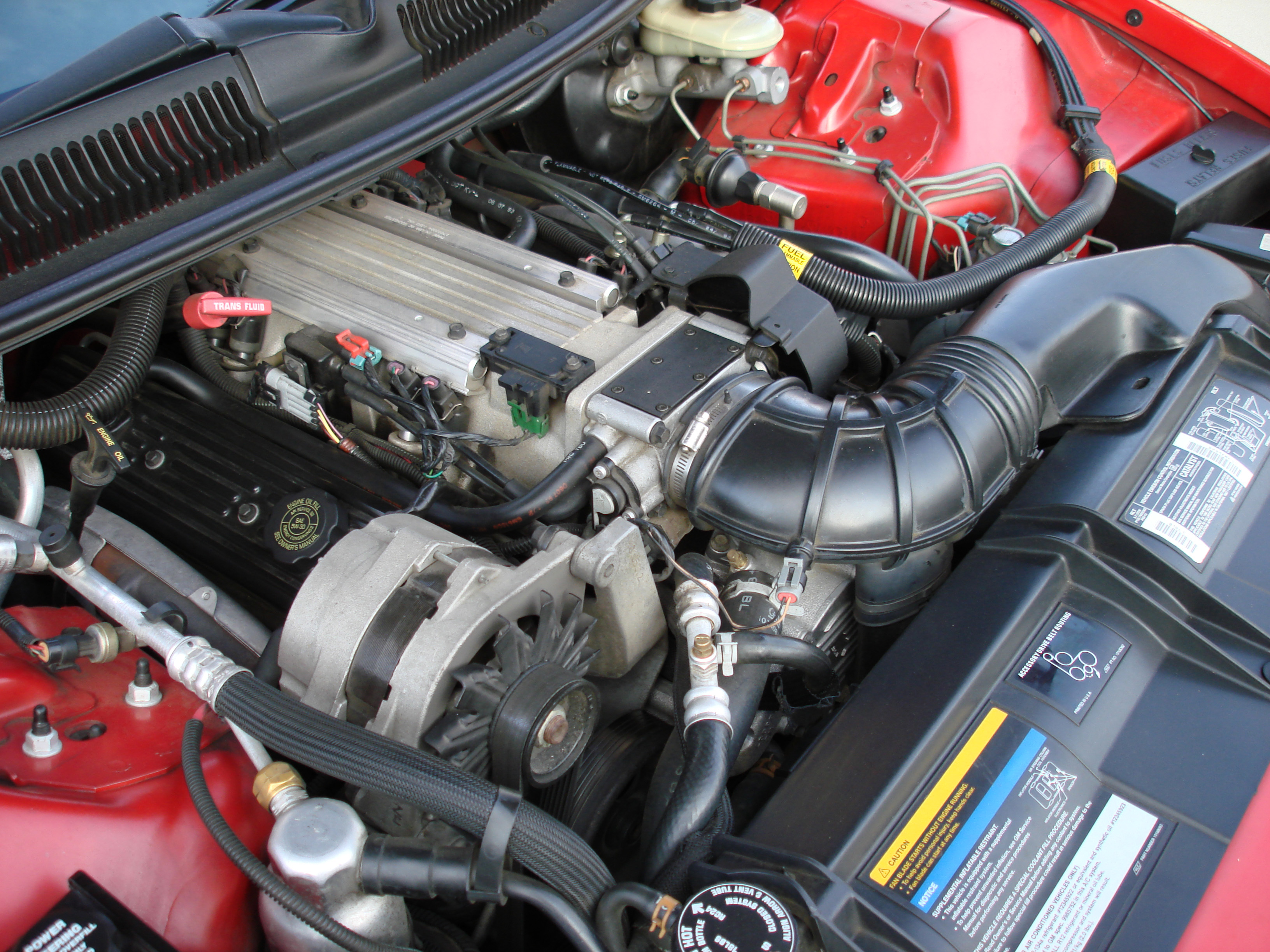 The fourth generation of the Camaro was introduced in January 1993, as a 1993 model. The production was moved from GM's
The fourth generation of the Camaro was introduced in January 1993, as a 1993 model. The production was moved from GM's
 The high performance Z28 model came with rectangular dual exhaust tips to distinguish it from the base models. The Z28 featured the 5.7 L OHV LT1 V8 engine having a power output of and of torque that had been introduced on the
The high performance Z28 model came with rectangular dual exhaust tips to distinguish it from the base models. The Z28 featured the 5.7 L OHV LT1 V8 engine having a power output of and of torque that had been introduced on the
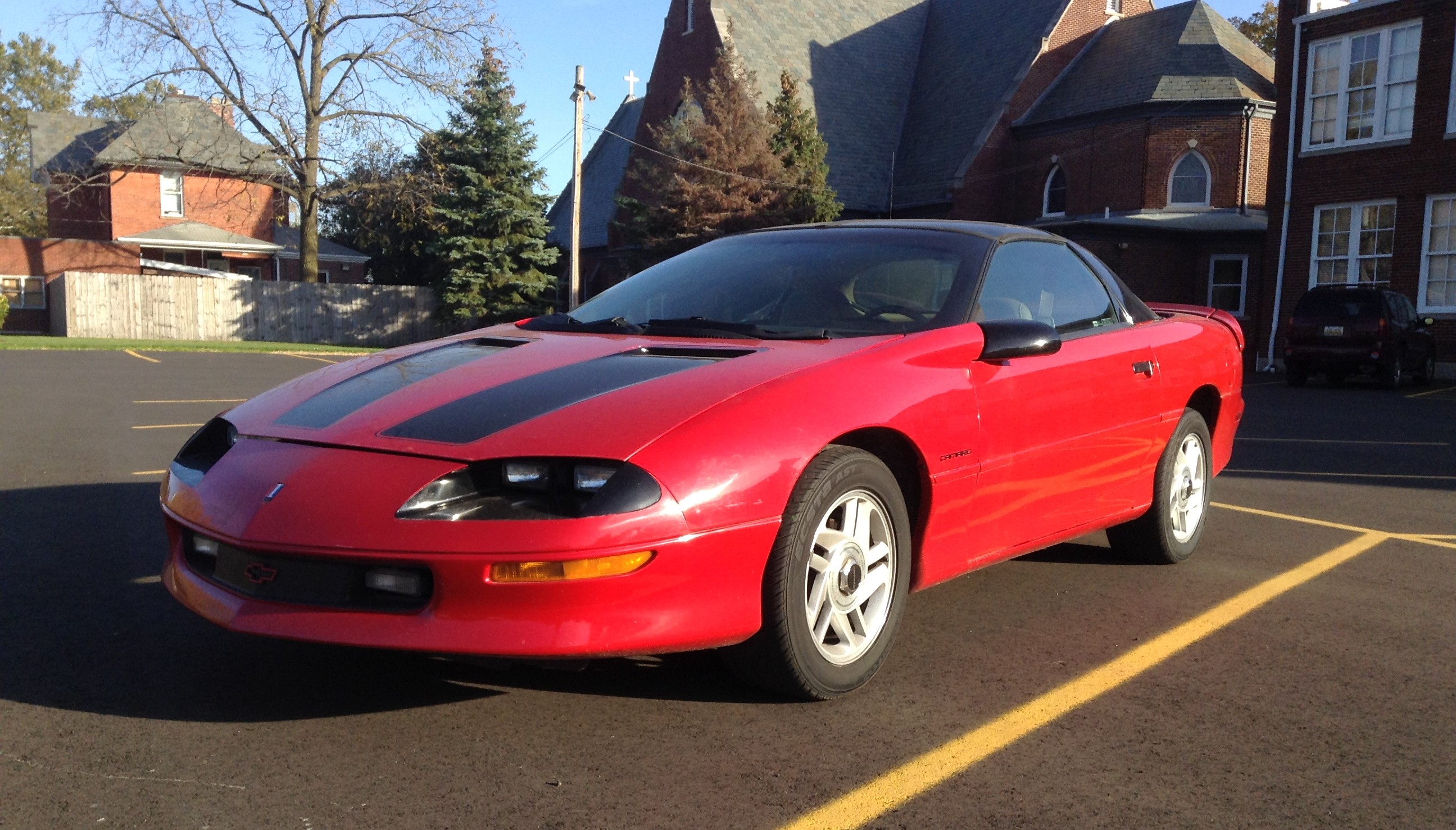 Several changes were made for the 1994 model year. The mechanically controlled and operated 4L60 automatic transmission was replaced with the electronically operated and controlled 4L60E, which was shared with other GM vehicles with V8s, such as the Tahoe. Accordingly, the car's on-board computer was modified from dealing only with the engine as in 1993 (ECM), to controlling both the engine and transmission on automatic models (PCM).
The computer in 1993 was run via Speed Density system, which measured engine speed (RPM) and load (MAP in kPa) to compute airflow requirements and then use that against the VE (Volumetric Efficiency) table to closely estimate the amount of fuel to be injected. An Intake Air Temperature (IAT) sensor was also used, as air density changes with temperature. In 1994 however, the computer logic was changed to a Mass Air Flow system. This system uses a Mass Air Flow Sensor placed in front of the throttle body to measure incoming airflow into the motor by using a heated wire sensor in the airstream path, which has heat pulled away from it via the incoming air. The reduced heat is converted into a voltage signal, read by the PCM which interprets that voltage signal as mass flow. The computer uses engine sensors to judge engine conditions and provide the proper fueling off of this mass airflow reading. Another prominent difference between 1993 and 1994 systems is how the programming (or custom tuning) of the computer takes place. In 1993, the computer used a removable Memcal chip essential to run the systems. In 1994, this was swapped to a non-removable reflashable chip, which could be reprogrammed via the Assembly Line Diagnostic Link (ALDL) located underneath the driver's side of the dashboard, next to the center console.
Dashboard gauge graphics were changed from yellow to white. There was also a spot in the gauge cluster reading ''ASR off''. Although GM had intended to install ASR or Acceleration Slip Regulation (called "TCS" by Pontiac) in the 1994 F-body models, it did not make it into production until the following model year. The Z28 received updated front brakes and cooling fans were changed mid-year from a parallel to a series setup. At low RPM, both fans operated on 6 V, but on high RPM, both operated on 12 V. Performance figures for the Z28 include a 0–60 mph acceleration time of 5.7 seconds and quarter-mile times of 14.2 seconds.
Several changes were made for the 1994 model year. The mechanically controlled and operated 4L60 automatic transmission was replaced with the electronically operated and controlled 4L60E, which was shared with other GM vehicles with V8s, such as the Tahoe. Accordingly, the car's on-board computer was modified from dealing only with the engine as in 1993 (ECM), to controlling both the engine and transmission on automatic models (PCM).
The computer in 1993 was run via Speed Density system, which measured engine speed (RPM) and load (MAP in kPa) to compute airflow requirements and then use that against the VE (Volumetric Efficiency) table to closely estimate the amount of fuel to be injected. An Intake Air Temperature (IAT) sensor was also used, as air density changes with temperature. In 1994 however, the computer logic was changed to a Mass Air Flow system. This system uses a Mass Air Flow Sensor placed in front of the throttle body to measure incoming airflow into the motor by using a heated wire sensor in the airstream path, which has heat pulled away from it via the incoming air. The reduced heat is converted into a voltage signal, read by the PCM which interprets that voltage signal as mass flow. The computer uses engine sensors to judge engine conditions and provide the proper fueling off of this mass airflow reading. Another prominent difference between 1993 and 1994 systems is how the programming (or custom tuning) of the computer takes place. In 1993, the computer used a removable Memcal chip essential to run the systems. In 1994, this was swapped to a non-removable reflashable chip, which could be reprogrammed via the Assembly Line Diagnostic Link (ALDL) located underneath the driver's side of the dashboard, next to the center console.
Dashboard gauge graphics were changed from yellow to white. There was also a spot in the gauge cluster reading ''ASR off''. Although GM had intended to install ASR or Acceleration Slip Regulation (called "TCS" by Pontiac) in the 1994 F-body models, it did not make it into production until the following model year. The Z28 received updated front brakes and cooling fans were changed mid-year from a parallel to a series setup. At low RPM, both fans operated on 6 V, but on high RPM, both operated on 12 V. Performance figures for the Z28 include a 0–60 mph acceleration time of 5.7 seconds and quarter-mile times of 14.2 seconds.
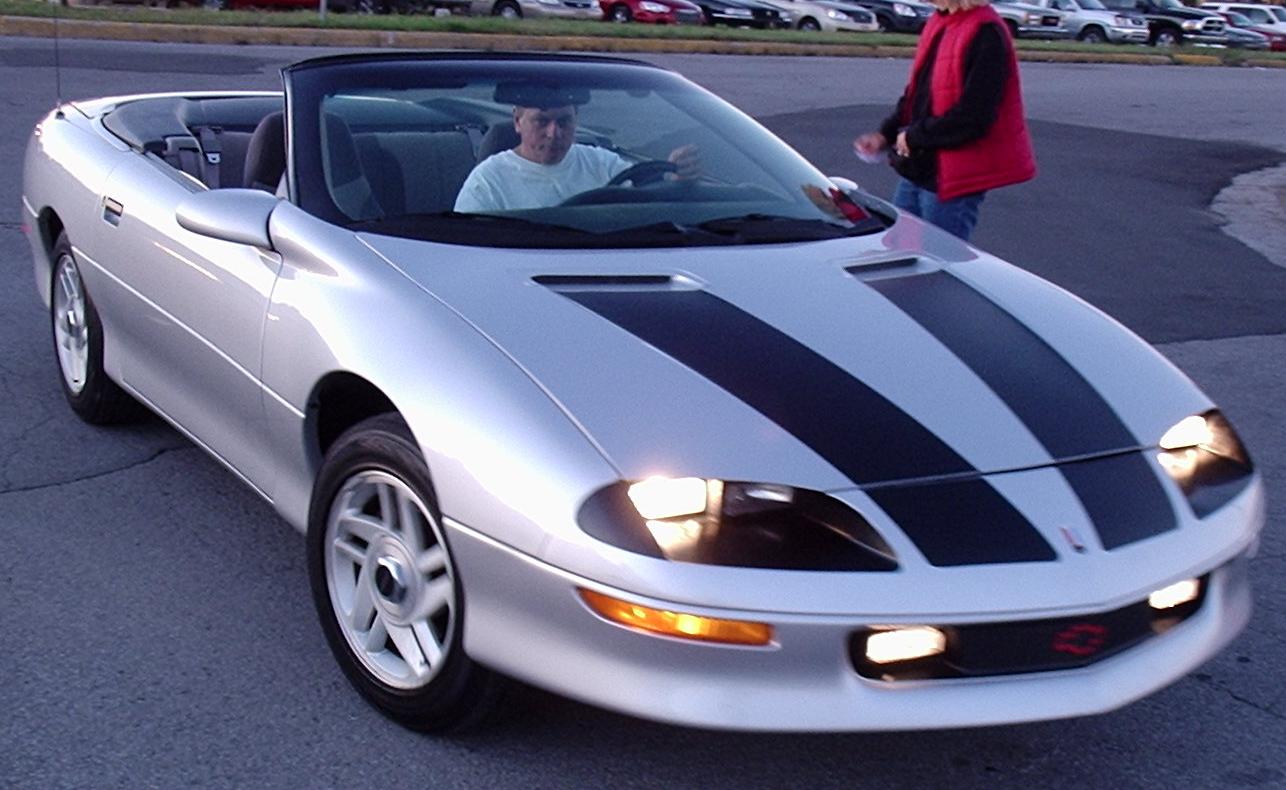 In 1995, the 3800 Series II V6 engine joined the 3.4 liter V6 engine offered on the base models thus giving the buyers a choice of two V6 engines for the first time. The 3800 engine had a power output of and would eventually replace the 3.4 liter V6 engine due to its more refined nature. The LT1 V8 had a power output of . The high performance variant of the Z28 called the Z28 SS was not introduced until 1996 in collaboration with SLP Engineering with the engine tuned to have a power output of . 17-inch wheels also became available as an option.
In 1995, the 3800 Series II V6 engine joined the 3.4 liter V6 engine offered on the base models thus giving the buyers a choice of two V6 engines for the first time. The 3800 engine had a power output of and would eventually replace the 3.4 liter V6 engine due to its more refined nature. The LT1 V8 had a power output of . The high performance variant of the Z28 called the Z28 SS was not introduced until 1996 in collaboration with SLP Engineering with the engine tuned to have a power output of . 17-inch wheels also became available as an option.
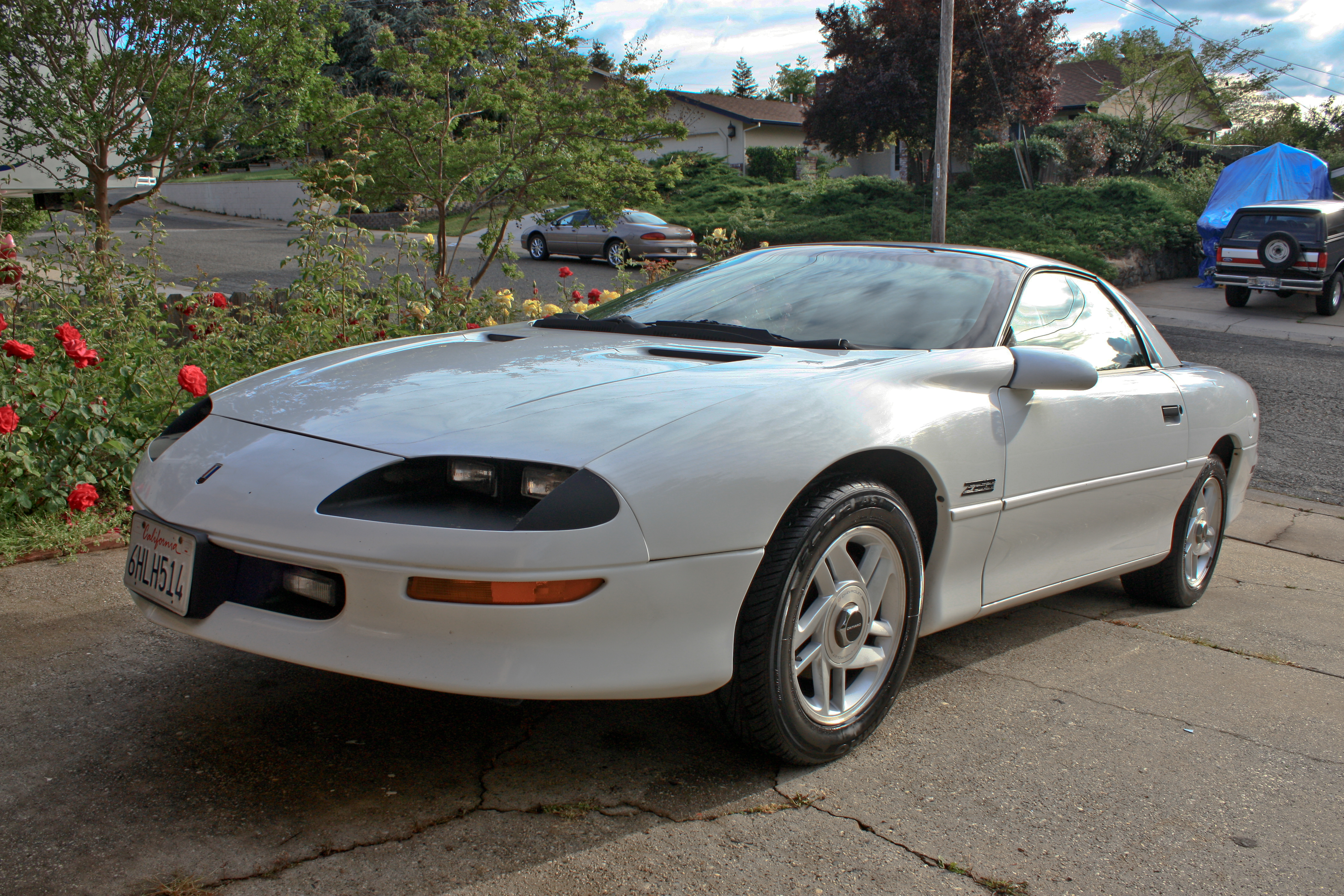 1996 saw minor mechanical revisions, as well as small power gains from the new OBD II-compliant engine controls. All base models were now equipped with the 3800 series II V6 engine rated at 200 hp. New wheel and tire package on the SS resulted in better handling and braking compared to the Z28. Convertible Super Sport cars however had 16-inch ZR1 style wheels. Also available this year for the V6 model was the Y87 package, which included an Auburn limited-slip differential, better tires, dual exhaust tips, 4-wheel disc brakes, a sportier steering ratio, and more aggressive gear ratio in the differential for automatic transmission equipped cars.
1996 saw minor mechanical revisions, as well as small power gains from the new OBD II-compliant engine controls. All base models were now equipped with the 3800 series II V6 engine rated at 200 hp. New wheel and tire package on the SS resulted in better handling and braking compared to the Z28. Convertible Super Sport cars however had 16-inch ZR1 style wheels. Also available this year for the V6 model was the Y87 package, which included an Auburn limited-slip differential, better tires, dual exhaust tips, 4-wheel disc brakes, a sportier steering ratio, and more aggressive gear ratio in the differential for automatic transmission equipped cars.
 For the 1997 model year, the Camaro featured a new interior and tri-colored taillights that would be standard on all models from 1997 to 2002. A "30th Anniversary Limited Edition" trim package, commemorating 30 years since the Camaro was introduced, was added to the range which included unique orange stripes on white base paint. It was only available on the Z28 and SS models. A 30th Anniversary Camaro may be identified by RPO code Z4C on the trim tag. A total of 979 30th Anniversary models were made in 1997. New 5-spoke 16-inch wheels became standard on the Z28 this year (17-inch ZR-1 style on SS coupé models) available in either polished, chrome, or white (only on the 30th Anniversary models), replacing the previous 10-spoke turbine style design.
For the 1997 model year, the Camaro featured a new interior and tri-colored taillights that would be standard on all models from 1997 to 2002. A "30th Anniversary Limited Edition" trim package, commemorating 30 years since the Camaro was introduced, was added to the range which included unique orange stripes on white base paint. It was only available on the Z28 and SS models. A 30th Anniversary Camaro may be identified by RPO code Z4C on the trim tag. A total of 979 30th Anniversary models were made in 1997. New 5-spoke 16-inch wheels became standard on the Z28 this year (17-inch ZR-1 style on SS coupé models) available in either polished, chrome, or white (only on the 30th Anniversary models), replacing the previous 10-spoke turbine style design.
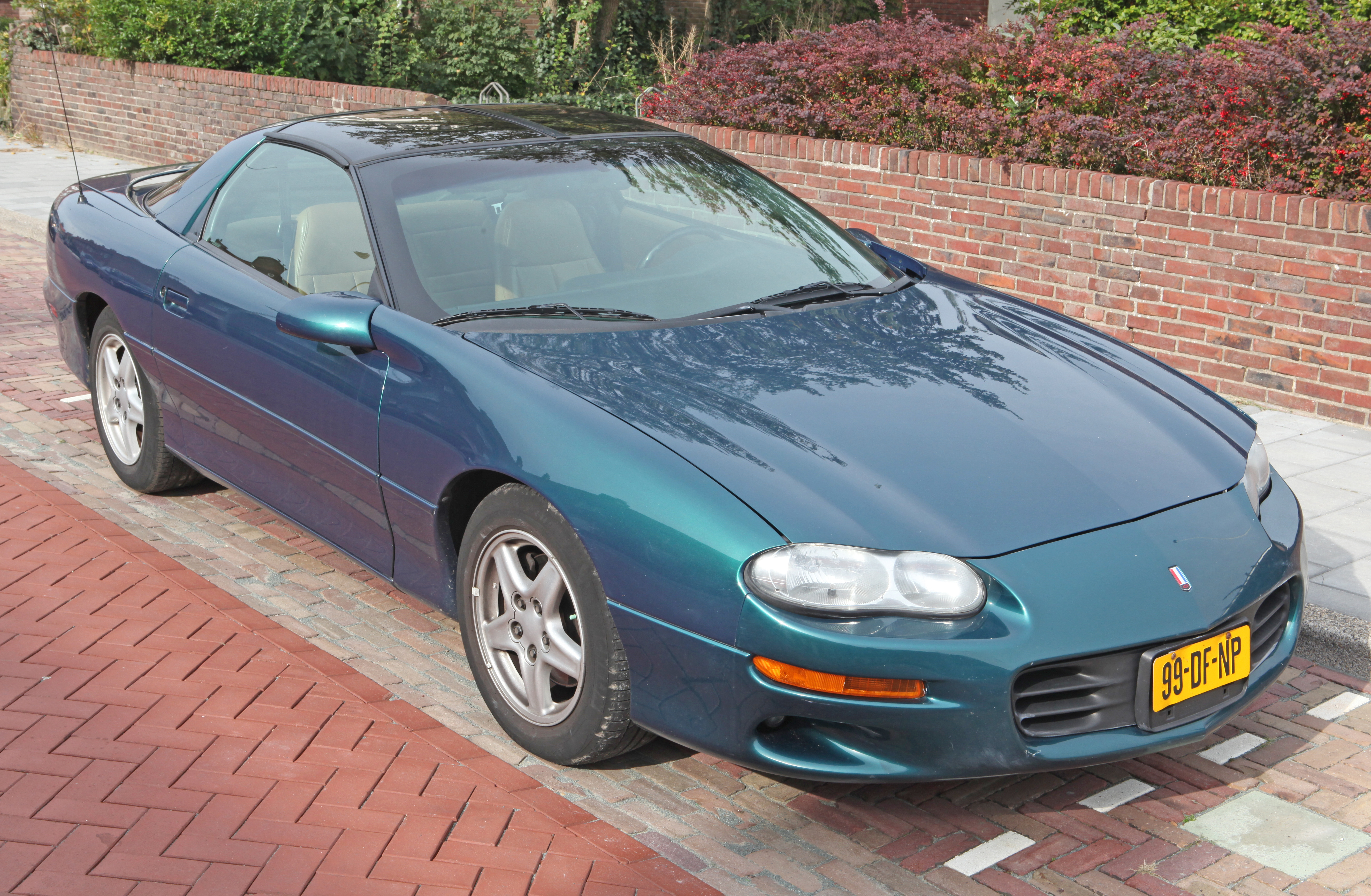
 For the 1998 model year, the Camaro received a facelift and now had a new front clip. This replaced the quartet of square inset headlights. Replacing the LT1 engine was the all-new 5.7 L (346 cuin) LS1 V8 engine rated at , which had been introduced in the 1997
For the 1998 model year, the Camaro received a facelift and now had a new front clip. This replaced the quartet of square inset headlights. Replacing the LT1 engine was the all-new 5.7 L (346 cuin) LS1 V8 engine rated at , which had been introduced in the 1997
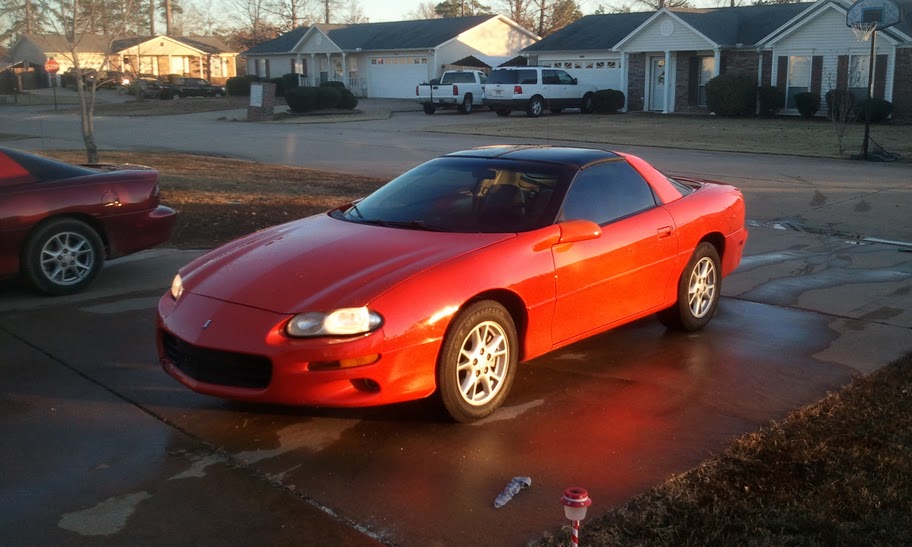 The 1999 model year saw only a few minor changes made to the Camaro. These included the introduction of new colors such as "Hugger Orange". The fuel tanks were now made of plastic with a 16.8 gallon capacity instead of preceding metal units which had a capacity of 15.5 gallons. The valve covers on the LS1 powered models were switched to a center-bolt style, and traction control now became available on the V6 models. A new "oil change" light was added to the instrument cluster as General Motors introduced their early oil-life monitoring systems. Coolant temperature gauges were replaced with a dummy gauge. A Torsen differential was added for the Z28 and SS models. 1999 was the last model year for the RPO 1LE performance option which included factory installed double adjustable Koni shocks, stiffer springs, a larger front and rear anti-roll bars, and stiffer suspension bushings.
The 1999 model year saw only a few minor changes made to the Camaro. These included the introduction of new colors such as "Hugger Orange". The fuel tanks were now made of plastic with a 16.8 gallon capacity instead of preceding metal units which had a capacity of 15.5 gallons. The valve covers on the LS1 powered models were switched to a center-bolt style, and traction control now became available on the V6 models. A new "oil change" light was added to the instrument cluster as General Motors introduced their early oil-life monitoring systems. Coolant temperature gauges were replaced with a dummy gauge. A Torsen differential was added for the Z28 and SS models. 1999 was the last model year for the RPO 1LE performance option which included factory installed double adjustable Koni shocks, stiffer springs, a larger front and rear anti-roll bars, and stiffer suspension bushings.
Chevrolet Camaro
The Chevrolet Camaro is a mid-size American automobile manufactured by Chevrolet, classified as a pony car. It first went on sale on September 29, 1966, for the 1967 model year and was designed to compete with the Ford Mustang. The Camaro share ...
is a pony car
Pony car is an American car classification for affordable, compact, highly styled coupés or convertibles with a "sporty" or performance-oriented image. Common characteristics include rear-wheel drive, a long hood, a short decklid, a wide range ...
that was produced by American automobile manufacturer General Motors
The General Motors Company (GM) is an American Multinational corporation, multinational Automotive industry, automotive manufacturing company headquartered in Detroit, Michigan, United States. It is the largest automaker in the United States and ...
for the 1993 through 2002 model years. It was introduced on an updated F-body platform, but retained the same characteristic since the first-generation's introduction back in 1967; 2-doors, 2+2 seating, coupé
A coupe or coupé (, ) is a passenger car with a sloping or truncated rear roofline and two doors.
The term ''coupé'' was first applied to horse-drawn carriages for two passengers without rear-facing seats. It comes from the French past parti ...
(with optional T-top
A T-top (UK: T-bar) is an automobile roof with a removable panel on each side of a rigid bar running from the center of one structural bar between Pillar (car), pillars to the center of the next structural bar. The panels of a traditional T-to ...
roof) or convertible
A convertible or cabriolet () is a passenger car that can be driven with or without a roof in place. The methods of retracting and storing the roof vary among eras and manufacturers.
A convertible car's design allows an open-air driving expe ...
bodystyles, rear-wheel drive
Rear-wheel drive (RWD) is a form of engine and transmission layout used in motor vehicles, in which the engine drives the rear wheels only. Until the late 20th century, rear-wheel drive was the most common configuration for cars.
Most rear-wheel ...
, and a choice of OHV
An overhead valve (OHV) engine, sometimes called a ''pushrod engine'', is a piston engine whose valves are located in the cylinder head above the combustion chamber. This contrasts with earlier flathead engines, where the valves were located bel ...
V6 and V8 engines. The Camaro was revised in 1998 with both exterior and engine changes. General Motors
The General Motors Company (GM) is an American Multinational corporation, multinational Automotive industry, automotive manufacturing company headquartered in Detroit, Michigan, United States. It is the largest automaker in the United States and ...
discontinued production of the fourth generation of the Camaro due to slow sales, a deteriorated sports coupé market, and plant overcapacity.
1993–1997
1993
 The fourth generation of the Camaro was introduced in January 1993, as a 1993 model. The production was moved from GM's
The fourth generation of the Camaro was introduced in January 1993, as a 1993 model. The production was moved from GM's Van Nuys, California
Van Nuys () is a neighborhood in the central San Fernando Valley region of Los Angeles, California. Home to Van Nuys Airport and the Valley Municipal Building, it is the most populous neighborhood in the San Fernando Valley.
History
In 1909, ...
assembly plant to Sainte-Thérèse, Quebec
Sainte-Thérèse is an off-island suburb northwest of Montreal, in southwestern Quebec, Canada, in the Thérèse-De Blainville Regional County Municipality.
The town is mostly known as a home for heavy industry, but it is also a centre of re ...
, Canada from November 1992. The new design incorporated sheet moulding compound
Sheet moulding compound (SMC) or sheet moulding composite is a ready to mould glass-fibre reinforced polyester material primarily used in compression moulding. The sheet is provided in rolls weighing up to 1000 kg. Alternatively the resin an ...
(SMC) made from chopped fiberglass and polyester resin for the roof, hatch, doors, and spoiler. Both the front and rear suspension design was improved over its predecessor. The base models were powered by a 3.4 L OHV V6 engine equipped with a 5-speed manual transmission as standard. The 4-speed 4L60 automatic transmission was optional. All models came with a red Chevrolet Bowtie on the grille. 1993 was the only year interior instruments had yellow lettering (this is one way to tell the 1993 models from the 1994 which had white interior instrument lettering).
Z28
 The high performance Z28 model came with rectangular dual exhaust tips to distinguish it from the base models. The Z28 featured the 5.7 L OHV LT1 V8 engine having a power output of and of torque that had been introduced on the
The high performance Z28 model came with rectangular dual exhaust tips to distinguish it from the base models. The Z28 featured the 5.7 L OHV LT1 V8 engine having a power output of and of torque that had been introduced on the Corvette
A corvette is a small warship. It is traditionally the smallest class of vessel considered to be a proper (or " rated") warship. The warship class above the corvette is that of the frigate, while the class below was historically that of the slo ...
one year earlier. The V8 engine came standard with a 4-speed (4L60) automatic transmission, although the Borg-Warner T56 6-speed manual transmission was a no cost option. In 1993, the Camaro Z28 was selected as the official pace car for the Indianapolis 500
The Indianapolis 500, formally known as the Indianapolis 500-Mile Race, and commonly called the Indy 500, is an annual automobile race held at Indianapolis Motor Speedway (IMS) in Speedway, Indiana, United States, an enclave suburb of Indi ...
. A special "pace car edition" trim was introduced in the same year and featured "Indy 500" lettering on black and white body color scheme with multicolored pinstriping and white painted wheels. 645 units were made.
1994
 Several changes were made for the 1994 model year. The mechanically controlled and operated 4L60 automatic transmission was replaced with the electronically operated and controlled 4L60E, which was shared with other GM vehicles with V8s, such as the Tahoe. Accordingly, the car's on-board computer was modified from dealing only with the engine as in 1993 (ECM), to controlling both the engine and transmission on automatic models (PCM).
The computer in 1993 was run via Speed Density system, which measured engine speed (RPM) and load (MAP in kPa) to compute airflow requirements and then use that against the VE (Volumetric Efficiency) table to closely estimate the amount of fuel to be injected. An Intake Air Temperature (IAT) sensor was also used, as air density changes with temperature. In 1994 however, the computer logic was changed to a Mass Air Flow system. This system uses a Mass Air Flow Sensor placed in front of the throttle body to measure incoming airflow into the motor by using a heated wire sensor in the airstream path, which has heat pulled away from it via the incoming air. The reduced heat is converted into a voltage signal, read by the PCM which interprets that voltage signal as mass flow. The computer uses engine sensors to judge engine conditions and provide the proper fueling off of this mass airflow reading. Another prominent difference between 1993 and 1994 systems is how the programming (or custom tuning) of the computer takes place. In 1993, the computer used a removable Memcal chip essential to run the systems. In 1994, this was swapped to a non-removable reflashable chip, which could be reprogrammed via the Assembly Line Diagnostic Link (ALDL) located underneath the driver's side of the dashboard, next to the center console.
Dashboard gauge graphics were changed from yellow to white. There was also a spot in the gauge cluster reading ''ASR off''. Although GM had intended to install ASR or Acceleration Slip Regulation (called "TCS" by Pontiac) in the 1994 F-body models, it did not make it into production until the following model year. The Z28 received updated front brakes and cooling fans were changed mid-year from a parallel to a series setup. At low RPM, both fans operated on 6 V, but on high RPM, both operated on 12 V. Performance figures for the Z28 include a 0–60 mph acceleration time of 5.7 seconds and quarter-mile times of 14.2 seconds.
Several changes were made for the 1994 model year. The mechanically controlled and operated 4L60 automatic transmission was replaced with the electronically operated and controlled 4L60E, which was shared with other GM vehicles with V8s, such as the Tahoe. Accordingly, the car's on-board computer was modified from dealing only with the engine as in 1993 (ECM), to controlling both the engine and transmission on automatic models (PCM).
The computer in 1993 was run via Speed Density system, which measured engine speed (RPM) and load (MAP in kPa) to compute airflow requirements and then use that against the VE (Volumetric Efficiency) table to closely estimate the amount of fuel to be injected. An Intake Air Temperature (IAT) sensor was also used, as air density changes with temperature. In 1994 however, the computer logic was changed to a Mass Air Flow system. This system uses a Mass Air Flow Sensor placed in front of the throttle body to measure incoming airflow into the motor by using a heated wire sensor in the airstream path, which has heat pulled away from it via the incoming air. The reduced heat is converted into a voltage signal, read by the PCM which interprets that voltage signal as mass flow. The computer uses engine sensors to judge engine conditions and provide the proper fueling off of this mass airflow reading. Another prominent difference between 1993 and 1994 systems is how the programming (or custom tuning) of the computer takes place. In 1993, the computer used a removable Memcal chip essential to run the systems. In 1994, this was swapped to a non-removable reflashable chip, which could be reprogrammed via the Assembly Line Diagnostic Link (ALDL) located underneath the driver's side of the dashboard, next to the center console.
Dashboard gauge graphics were changed from yellow to white. There was also a spot in the gauge cluster reading ''ASR off''. Although GM had intended to install ASR or Acceleration Slip Regulation (called "TCS" by Pontiac) in the 1994 F-body models, it did not make it into production until the following model year. The Z28 received updated front brakes and cooling fans were changed mid-year from a parallel to a series setup. At low RPM, both fans operated on 6 V, but on high RPM, both operated on 12 V. Performance figures for the Z28 include a 0–60 mph acceleration time of 5.7 seconds and quarter-mile times of 14.2 seconds.
1995
 In 1995, the 3800 Series II V6 engine joined the 3.4 liter V6 engine offered on the base models thus giving the buyers a choice of two V6 engines for the first time. The 3800 engine had a power output of and would eventually replace the 3.4 liter V6 engine due to its more refined nature. The LT1 V8 had a power output of . The high performance variant of the Z28 called the Z28 SS was not introduced until 1996 in collaboration with SLP Engineering with the engine tuned to have a power output of . 17-inch wheels also became available as an option.
In 1995, the 3800 Series II V6 engine joined the 3.4 liter V6 engine offered on the base models thus giving the buyers a choice of two V6 engines for the first time. The 3800 engine had a power output of and would eventually replace the 3.4 liter V6 engine due to its more refined nature. The LT1 V8 had a power output of . The high performance variant of the Z28 called the Z28 SS was not introduced until 1996 in collaboration with SLP Engineering with the engine tuned to have a power output of . 17-inch wheels also became available as an option.
1996
 1996 saw minor mechanical revisions, as well as small power gains from the new OBD II-compliant engine controls. All base models were now equipped with the 3800 series II V6 engine rated at 200 hp. New wheel and tire package on the SS resulted in better handling and braking compared to the Z28. Convertible Super Sport cars however had 16-inch ZR1 style wheels. Also available this year for the V6 model was the Y87 package, which included an Auburn limited-slip differential, better tires, dual exhaust tips, 4-wheel disc brakes, a sportier steering ratio, and more aggressive gear ratio in the differential for automatic transmission equipped cars.
1996 saw minor mechanical revisions, as well as small power gains from the new OBD II-compliant engine controls. All base models were now equipped with the 3800 series II V6 engine rated at 200 hp. New wheel and tire package on the SS resulted in better handling and braking compared to the Z28. Convertible Super Sport cars however had 16-inch ZR1 style wheels. Also available this year for the V6 model was the Y87 package, which included an Auburn limited-slip differential, better tires, dual exhaust tips, 4-wheel disc brakes, a sportier steering ratio, and more aggressive gear ratio in the differential for automatic transmission equipped cars.
1997
 For the 1997 model year, the Camaro featured a new interior and tri-colored taillights that would be standard on all models from 1997 to 2002. A "30th Anniversary Limited Edition" trim package, commemorating 30 years since the Camaro was introduced, was added to the range which included unique orange stripes on white base paint. It was only available on the Z28 and SS models. A 30th Anniversary Camaro may be identified by RPO code Z4C on the trim tag. A total of 979 30th Anniversary models were made in 1997. New 5-spoke 16-inch wheels became standard on the Z28 this year (17-inch ZR-1 style on SS coupé models) available in either polished, chrome, or white (only on the 30th Anniversary models), replacing the previous 10-spoke turbine style design.
For the 1997 model year, the Camaro featured a new interior and tri-colored taillights that would be standard on all models from 1997 to 2002. A "30th Anniversary Limited Edition" trim package, commemorating 30 years since the Camaro was introduced, was added to the range which included unique orange stripes on white base paint. It was only available on the Z28 and SS models. A 30th Anniversary Camaro may be identified by RPO code Z4C on the trim tag. A total of 979 30th Anniversary models were made in 1997. New 5-spoke 16-inch wheels became standard on the Z28 this year (17-inch ZR-1 style on SS coupé models) available in either polished, chrome, or white (only on the 30th Anniversary models), replacing the previous 10-spoke turbine style design.
30th Anniversary LT4 SS
An additional 108 30th Anniversary models were modified by SLP Engineering equipment with the LT4 V8 engine having a power output of and of torque. 100 cars were allocated to the US market while 6 cars were sold to Canadian buyers. The remaining 2 were prototypes. These models have the R7T RPO code. The LT4 was the fastest factory-built Camaro available, as well as the most expensive atUS$
The United States dollar (symbol: $; code: USD; also abbreviated US$ or U.S. Dollar, to distinguish it from other dollar-denominated currencies; referred to as the dollar, U.S. dollar, American dollar, or colloquially buck) is the official ...
40,000.
1998–2002
1998

 For the 1998 model year, the Camaro received a facelift and now had a new front clip. This replaced the quartet of square inset headlights. Replacing the LT1 engine was the all-new 5.7 L (346 cuin) LS1 V8 engine rated at , which had been introduced in the 1997
For the 1998 model year, the Camaro received a facelift and now had a new front clip. This replaced the quartet of square inset headlights. Replacing the LT1 engine was the all-new 5.7 L (346 cuin) LS1 V8 engine rated at , which had been introduced in the 1997 Corvette
A corvette is a small warship. It is traditionally the smallest class of vessel considered to be a proper (or " rated") warship. The warship class above the corvette is that of the frigate, while the class below was historically that of the slo ...
. The new engine featured an aluminum cylinder block with iron sleeves, reducing weight by about as compared to the iron block LT1 engine. 1998 was the only year LS1 powered models had a working coolant temperature gauge. Minor changes were made to the suspension and the brakes were increased in size. Total production for 1998 was 48,495 units in total.
1999
 The 1999 model year saw only a few minor changes made to the Camaro. These included the introduction of new colors such as "Hugger Orange". The fuel tanks were now made of plastic with a 16.8 gallon capacity instead of preceding metal units which had a capacity of 15.5 gallons. The valve covers on the LS1 powered models were switched to a center-bolt style, and traction control now became available on the V6 models. A new "oil change" light was added to the instrument cluster as General Motors introduced their early oil-life monitoring systems. Coolant temperature gauges were replaced with a dummy gauge. A Torsen differential was added for the Z28 and SS models. 1999 was the last model year for the RPO 1LE performance option which included factory installed double adjustable Koni shocks, stiffer springs, a larger front and rear anti-roll bars, and stiffer suspension bushings.
The 1999 model year saw only a few minor changes made to the Camaro. These included the introduction of new colors such as "Hugger Orange". The fuel tanks were now made of plastic with a 16.8 gallon capacity instead of preceding metal units which had a capacity of 15.5 gallons. The valve covers on the LS1 powered models were switched to a center-bolt style, and traction control now became available on the V6 models. A new "oil change" light was added to the instrument cluster as General Motors introduced their early oil-life monitoring systems. Coolant temperature gauges were replaced with a dummy gauge. A Torsen differential was added for the Z28 and SS models. 1999 was the last model year for the RPO 1LE performance option which included factory installed double adjustable Koni shocks, stiffer springs, a larger front and rear anti-roll bars, and stiffer suspension bushings.
2000
Changes for 2000 were also largely cosmetic in nature. Monterey Maroon Metallic was added as an optional color, similar to the previously available Medium Patriot Red. The SS, however, was not available in this color. The black exterior color was now renamed Ebony. Previously, all V8 powered models had side mirrors painted in this color. A new four-spoke steering wheel, as found in other GM models of the time, was introduced to replace the two-spoke steering wheel dating back to the 1993 models. New 10-spoke 16-inch wheels became available, but the older 5-spoke wheels were still optional. The base models came with 16-inch steel wheels with hubcaps. The 3.8 L (231 ci) V6 and the 5.7 L (346 ci) LS1 V8 engines continued with no changes.2001
2001 proved to be the lowest production year for the Camaro with 29,009 units built. This was partially due to production ending earlier than usual to begin work on the 35th Anniversary models commemorating 35 years of the Camaro. The Z28 and SS models received the intake manifold from the LS6 engine, used on the Z06 from 2001 to 2004 and the first generation of theCadillac CTS-V
The Cadillac CTS is an executive car that was manufactured and marketed by General Motors from 2003 until 2019 across three generations. Historically, it was priced similarly to cars on the compact luxury spectrum; but it has always been size ...
from 2004 to 2005. This change also resulted in a revised camshaft profile and removal of the EGR system. Chevrolet also introduced a new slave cylinder for the clutch assembly that was superior to the design of previous years, as well as an LS6 clutch in manual models. Accordingly, the engine power output was increased to for the Z28 and for the SS which also added a power steering cooler. SLP Engineering reintroduced the RS model this year, which included rally stripes and stock cold air intake system along with the Z28 take-off exhaust from their SS conversions.
2002
The final fourth-generation Camaro was built on 27 August 2002 after which the Boisbriand plant, located in the province of Quebec just outside of Montreal then closed down. Total production for 2002 was 42,098 units. GM's Performance Division unveiled a Z28 show vehicle at the 2002Woodward Dream Cruise
The Woodward Dream Cruise event is an automotive enthusiast event held annually on the third Saturday of August in Metropolitan Detroit, Michigan, along Woodward Avenue, a major thoroughfare built in the early 20th century. The WDC Event spans muc ...
as a send off for the Camaro's 35-year heritage. It emulated the 1960s and 1970s Penske-Sunoco stock TransAm race team vehicles. The 35th Anniversary trim package was also available for the SS.
References
External links
* {{Chevrolet Camaro 4 Chevrolet Camaro 4 Chevrolet Camaro 4 Chevrolet Camaro 4 Chevrolet Camaro 4 Cars introduced in 1993